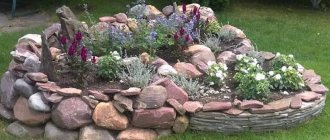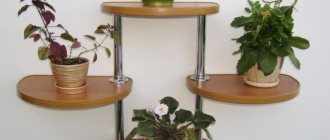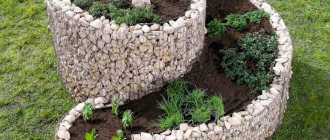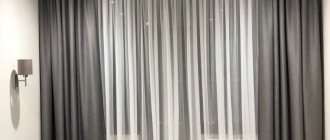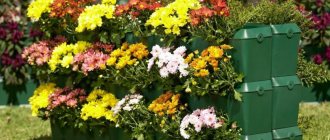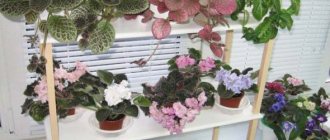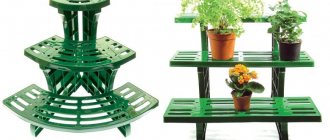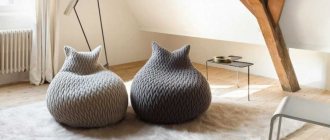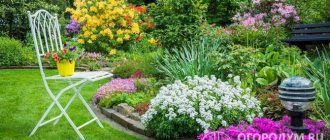One of the disadvantages of the classic arrangement of a house flower garden is associated with the rather low location of the plantings. Any tall grass, decorative fence or fence separating a section of the roadway completely covers the flowering carpet. You can get out of the situation in a fairly simple way - build high flower beds. The work is not much more than when setting up a regular flower garden. You just need to choose the right material and shape, correctly lay the soil in a high flower bed, as a result, visibility and visibility improves by an order of magnitude.
A climbing rose on special trellises will eventually turn into a hedge
Flower bed height
If you decide to make tall flower beds, try to imagine how it will look in combination with shrubs, trees and buildings. The flower garden can be miniature, only 20-25 cm high, and serve as a border. Or maybe one and a half meters high, for climbing plants and zoning space. When arranging the site, keep in mind that smooth transitions are impossible. Stepped flower beds look very impressive if the varieties and species are well selected.
Types of purchased structures
Today, specialized stores offer a wide range of ready-made designs that allow you to quickly and easily make a vertical flower bed with your own hands. These include wooden multi-level “pyramids” that can be moved around the site; wooden “ladders” with pallets; decorative flower pots and stands; pallets, metal and wooden boxes of various sizes; metal balls made of wire.
If you wish, you can realize your own needs and fantasies by making a custom-made structure based on an individual project. The only negative is the cost of such structures. Therefore, summer residents simply make do with what they have at hand, turning even household garbage and waste into stunning flower beds.
Installation Rules
To prevent perennial weeds from penetrating the soil, place dense material under the frame, for example, flat slate or a sheet of roofing iron. The site can be concreted. If the flower bed is very high, is used as a fence, or is intended for planting hanging plants, fill the lower half of the container with expanded clay and place a sheet of metal or roofing felt on top of the filler. After this, fill the remaining part with nutritious soil mixture. This will reduce the weight of the structure and make the work easier. Do not place tall flower beds in areas where strong winds blow. Plants will often be damaged and lose their beauty.
A simple option made from building blocks
The peculiarity of the design is that the flowers are planted in a recess inside the building block. Such a flower garden looks interesting, decorating a summer cottage.
First you need to decide on the shape of the flowerbed, then prepare a recess for the structure, pour a layer of crushed stone into the dug hole. The tiers of the structure are laid out using blocks, inside which earth is poured and flowers are planted.
Tiered flower beds can be made to order in specialized companies; the dimensions, materials used and design complexity are specified.
How to fill a high flower bed
If a tall flower garden is not intended for a specific type of plant with special soil requirements, use a nutritious soil mixture. It is not profitable to buy in such a volume; it is easier to prepare it yourself. To prepare, take leaf, turf or garden soil, mix it with humus, compost, peat and coarse sand in a ratio of 5:1:1:1:1. Add superphosphate to the finished mixture according to the instructions. Make sure that the roots of wheatgrass and other harmful weeds do not get into the mixture. To obtain a homogeneous soil, take small portions and mix thoroughly. It is advisable to fill the containers a month before planting so that the soil settles completely.
Interesting design ideas
Round flower beds can add special originality to landscape design. Summer residents show their imagination by building exclusive flower oases in the middle of the yard:
- flowerbed with a bridge in the middle;
- a fairy-tale carriage surrounded by a bright flower bed;
- women's hat;
- floral watches, which are already becoming classics, but always attract attention;
- a simple flowerbed with graying stump. But it looks quite impressive and aesthetically pleasing;
- flowerbed with living fencing.
As you can see, there are many interesting ideas for creating a flower garden on your site. The main thing is to know exactly what end result you need, choose the right plants, create a clear planting scheme and show your creative thinking. Then your yard will become unique, colorful and unusually beautiful in the warm season.
Advantages and disadvantages of tall flower beds
The only and very significant drawback of a high flower bed is the difficulty of filling the container with soil. This process is labor-intensive and requires great physical strength or the use of technology. Manufacturing costs vary greatly depending on size and materials. Financial costs can be large if several flower beds are installed at once.
Keep in mind that plants produce resources from the soil, and its volume is limited. The frequency of fertilizing and watering in containers is higher than in open ground.
Rock garden
It is a combination of stones of various sizes and shapes and plants.
Flowers for the rock garden are selected to be unpretentious and do not require special care. The size of the plants may also vary.
Plants for raised beds
Plant any plants that can be planted in open ground in high flower beds, with the exception of perennial species that freeze easily. The soil in such flower beds freezes more strongly than in the beds. An excellent solution for planting would be annual flowers with continuous flowering, such as petunias, low-growing varieties of dahlias, purslane, phlox, lobelia, bacola, verbena and many others.
Among the perennials, irises, lilies, hyacinths, lychnis, delphinium, and periwinkle are well suited.
Magnificent hanging plants and vines are simply created for this type of flower beds. Calibrachoa, ivy, begonias, pelargoniums, impatiens, antirrhinum, tradescantia, dichondra, chamomile, various vines.
It is appropriate to add herbs with beautiful flowering to compositions of perennials. Thyme is perfect; it not only has a good aroma, but is also able to repel harmful insects. A combination of colorful flowering annuals and ornamental foliage crops such as ferns, heuchera and hosta, which are hardy, will be great. Dwarf conifers and miniature shrubs fit well into the composition.
Naturally, your preferences when choosing varieties and species are yours, but take into account the characteristics of the plants, especially the winter hardiness of perennials.
How to choose the right flowers?
A flower bed with several levels must have a special design; usually, during watering, water in it flows from the upper levels to the lower. When selecting plants, a summer resident must take this circumstance into account in order to create optimal conditions for green spaces.
Suitable choices for high humidity levels in spring are primroses, ranunculus, forget-me-nots and violets, while irises and geraniums grow well here in summer; astilbes can replace them in August.
On the upper tiers you will need to plant drought-resistant flowers: cosmos, iberis, marigolds, nasturtium or aster. You need to know that these plants cannot survive without watering at all; at least water them once a week.
Perennials for a multi-level garden flower bed are far from the best option; the plants will have to be disturbed all the time in order to replant them.
In what style are tall flower beds appropriate?
In the photo, tall flower beds are always gorgeous, but this type of flower garden is not suitable for every style of plot. Naturgarden and country style does not involve the installation of such elements. They will be superfluous if the site emits natural nature, lawns and gracefully plays out the natural landscape with elevation changes and rocky slopes.
In a minimalist and strict style, on the contrary, decorative elements with clear geometric shapes emphasize conciseness and restraint.
In the landscaping of city parks, recreation areas and squares, tall flower beds will become the most striking elements. The photo shows that even the simplest options enliven the territory and make it possible to create some comfort. The benches against the background of flowers look beautiful, the aroma makes it possible to enjoy a walk.
How to make a diagram of a flower bed of continuous flowering perennials: examples
- A previously drawn up schematic picture of a future flowerbed of continuous flowering will help you better imagine what the combination of colors will look like , how many plant specimens will be needed, and which ones exactly. You can sketch out several diagrams to clearly see the advantages of a particular option and its applicability in the conditions of the area you have allocated for planting.
- The diagram can be drawn on a large sheet of paper, divided into cells, taking a scale for each cell: depending on the total area of your flower garden, you can consider one cell as a quarter or half a meter. Now fill the cells, looking for the optimal place for the plants that you plan to plant: this way you will clearly see who is next to whom, whether the flowers replace each other in terms of flowering time, whether they are combined in height and color scheme. In such a diagram, you can also provide for the diameter that a bush planting of a particular plant will reach in 3-4 years.
- The basic rules for filling a flower bed with perennials have already been described above. By adhering to them, you can create a flowerbed according to a pattern that will give you the opportunity to admire continuous flowering, starting from March-April and ending with the days of November.
Flowerbed diagram
Example 1:
A universal composition that combines specimens that bloom at different times. They are marked with the following positions:
- snow forsythia;
- lungwort;
- delphinium;
- herbaceous sunflower;
- miscanthus chinensis;
- Phlox paniculata;
- daffodils;
- helenium;
- hellebore;
- astrantia;
- coreopsis whorled;
- hare cabbage;
- geranium;
- aquilegia;
- catnip;
- sage;
- cushion aster;
- bellflower peach;
- portable flowerpot with seasonal plants;
- geranium;
- The cuff is soft.
Result
Scheme
Example 2:
Another option for a flower bed of perennial plants, which can be laid out both in the shade and in a well-lit place. This flowerbed is designed according to the principle of a year-round combination of yellow, red and blue-blue shades:
- stock-rose (can be any shade);
- ten-petalled sunflower;
- Iceland poppy;
- St. John's wort, odorless;
- cardinal's lobelia;
- Fassin's catnip;
- Poskharsky's bell;
- catananche blue;
- Gravilat Chilean Feuerball;
- sedum Matrona;
- Heuchera blood red.
Scheme
Example 3:
This diagram shows an autumn flower garden, in which there are:
- Thuja occidentalis "Yellow Ribbon";
- Three types of Echinacea: “Mama mia”, “Marmalade” and “Tangerine Dream”;
- Spiraea japonica "Golden Carpet";
- Penisetum foxtail "Little Bunny";
- Sedum “Black Beauty” (our better known name is sedum);
- Juniper "Lime Glow";
- Pennisetum bristly "Rubrum";
- Switchgrass "Rotstrahlbusch".
Combination
Example 4:
And here is an example of a diagram of a flowerbed of continuous flowering in the spring-summer period, following all the rules for placement according to plant height:
- geranium macrorhizomatous;
- sedum;
- Siberian iris;
- golden yarrow;
- peony bush "Rubra Plena";
- switchgrass bush “Heavy Metal”;
- common mordovnik bush.
Constant flowering
Example 5:
And here is an original decorative solution: the color scheme of the planted plants creates the illusion of a flowing stream:
- bamboo leaf (you can choose ostrich as a replacement option);
- irises;
- lobelia;
- creeping tenacious;
- Poskharsky's bell;
- aubrieta hybrids;
- Brunnera macrofolia;
- awl-leaved bryozoan;
- red creeping tenacious;
- and again, bamboo or ostrich, they will “close” the composition into a single whole.
Like a stream
On a note
There are several tips to help make your flower garden flawless:
- Do not use black color in the design, the ground will overheat.
- Fill the spaces between plants with decorative mulch or white forest moss. The moisture will last longer, and the beautiful background will be emphasized by bright flowers and leaves.
- Do not use colored wood chips as mulch under plants with white flowers; the color of the petals may change.
- Water frequently and in small portions so that the water does not stagnate. Be sure to make drainage holes.
- Cut off dried flowers, they spoil the appearance and take a lot of strength from the plant.
To choose the right color of material for creating a flower bed, take into account the color of buildings and fences on the site; blue goes well with red, white and purple. Orange with red and yellow, green with brown and red, purple with red and white.
New life
It often happens that a container or other large container is no longer in use, then there is always a place for such items in the flower garden. A plastic flower bed will become an integral part of the landscape design, and a wooden barrel with flowers fits well into the country style.
An antique chest of drawers that you inherited from your grandmother does not fit in with the Art Nouveau style that you are a fan of. However, you can come up with a more interesting purpose for that furniture covered in dust in the closet - place lavender and rosemary in its pull-out drawers.
Any unexpected options are welcome; use old things in a new role.
Advice from an experienced gardener: A multi-level flower bed looks most impressive when all the flowers bloom in it at the same time.
A DIY flower garden can delight you with original combinations of contrasting shades. No less attractive will be color schemes with transitions from one tone to another: for example, a red tint first to orange, and then to yellow.
To completely transform the site, you will need a minimum of available materials. Use your imagination and focus on your own taste preferences; turning a summer house into a blooming garden is a feasible task if you use all the recommendations mentioned in the article.
